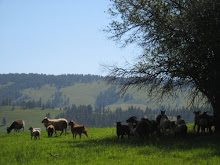
The first is a Leatherman multi tool. It doesn't matter if you are a survivalist, a homesteader or a business man sitting at his desk, these always come in handy.

The second is a nice Gerber pocket knife. I have a sheath for it that is slightly larger than the knife. This allows me to put a small LED flashlight, some string (some extremely strong black type used for necklaces), a small fire starter cube, matches and a mini compass. All of these things are very small and light. I really don't even realize they are in the sheath.

The third thing I carry is a lighter. The key here is to buy the lighters with the little LED lights in the bottom of them. They have a button on the side to turn the light on when needed. They also have the push down tops to light them rather than the wheels. I like this in case it is very cold and your fingers are having a hard time turning the wheel.
I wrap these lighters with a bunch of duct tape between the button and the top. This allows me to have a lighter, a flashlight and duct tape. I always find myself using the LED on the lighter. Whether it is to look into a dark tank or to find my way along a trail after dark, it has come in very handy almost daily. And I don't have to mention how valuable it is to have a little duct tape on hand.
So there you have it. Three things that improve my life daily.







